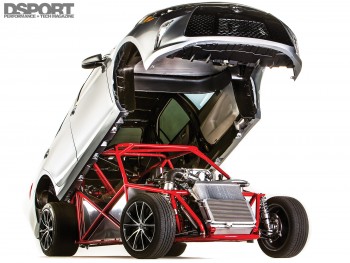Originally posted by Slonik
View Post
Will do.


 , so why we measure angles delta between both axles, one sensor on the front and second on the rear.
, so why we measure angles delta between both axles, one sensor on the front and second on the rear. The chassis and suspension of a vehicle can be thought of as five independent sets of springs. There are the two front springs, the two rear springs and the chassis that acts as a fifth spring. If we cut a car down the middle and only look at what happens to a single spring in the front and rear along with the chassis, we are able to consider a three-spring model. When three springs are put in series, the force or load across the springs is equal. The weakest spring in the series will still deflect the most for a given load even if the other two springs are upgraded to a higher rate (stiffness). This is why some vehicles do not respond favorably to high-rate springs unless the chassis rigidity is improved first. Finally, increased torsional rigidity decreases rattles, squeaks and vibrations.
The chassis and suspension of a vehicle can be thought of as five independent sets of springs. There are the two front springs, the two rear springs and the chassis that acts as a fifth spring. If we cut a car down the middle and only look at what happens to a single spring in the front and rear along with the chassis, we are able to consider a three-spring model. When three springs are put in series, the force or load across the springs is equal. The weakest spring in the series will still deflect the most for a given load even if the other two springs are upgraded to a higher rate (stiffness). This is why some vehicles do not respond favorably to high-rate springs unless the chassis rigidity is improved first. Finally, increased torsional rigidity decreases rattles, squeaks and vibrations.




Comment